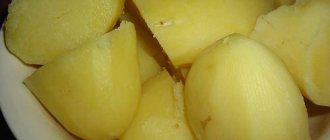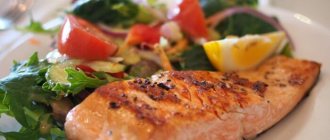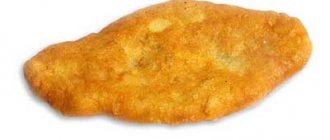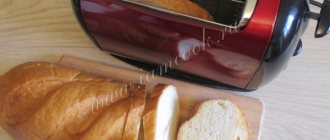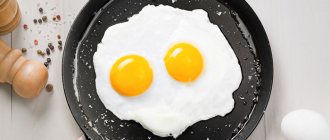Pollock is one of the most used and versatile fish among other fish.
You can prepare it in a variety of ways, and also figure out how many calories will be contained per 100 g serving of this product. Which fish tastes better?
- Cod 49%, 1237 votes
1237 votes 49%1237 votes - 49% of all votes
- Pollock 27%, 685 votes
685 votes 27%
685 votes - 27% of all votes
- Heck 23%, 581 votes
581 votes 23%
581 votes - 23% of all votes
Total votes: 2503
04.12.2019
- Cod 49%, 1237 votes
1237 votes 49%1237 votes - 49% of all votes
- Pollock 27%, 685 votes
685 votes 27%
685 votes - 27% of all votes
- Heck 23%, 581 votes
581 votes 23%
581 votes - 23% of all votes
Total votes: 2503
04.12.2019
×
You or from your IP have already voted.
Fried
When fried, pollock can increase the amount of fat content in its composition; it contains more than 100 kcal per 100 gram serving. Since the meat itself is lean, when frying fillets in batter or just fillets in a frying pan, use oil and add various sauces to the finished fish. Before cooking, you can also marinate pollock; often this dish can become the main dish on the holiday table.
Calorie content, consumption rate and methods of preparing pollock
The calorie content of pollock is 72 kcal per 100 grams.
The consumption rate greatly depends on various circumstances, but on average the recommended frequency of eating this healthy seafood product is 2 times a week.
Cooking methods are traditional for most dishes: boiling, frying, baking, drying, canning, steaming. Depending on the chosen method of heat treatment, the ingredients used and parts of the pollock - caviar, liver or fillet - the calorie content of the resulting dishes will vary.
The calorie content of boiled and steamed pollock is approximately the same. However, fish that has been boiled in a double boiler does not disintegrate until it is ready, which often happens when the product is boiled in a pan.
Calorie table for pollock of different types and cooking methods
| How many calories are in pollock? | Calorie content per 100 grams, kcal |
| Raw pollock fish (pollock fillet) | 72 |
| Steamed pollock | 75 |
| Pollock baked in the oven | 77 |
| Boiled pollock | 79 |
| Stewed pollock | 94 |
| Fried pollock | 111 |
| Pollock caviar | 132 |
| Dried pollock | 221 |
| Pollock in batter | 281 |
| Pollock liver | 474 |
Baked
This product is perfectly baked in the oven, you can immediately with or without a potato side dish, laying a layer of onions, cheese, and carrots on top. Pollock in marinade is interesting in taste and simple; the main products include: fish meat itself, flour, water, spices to taste, vegetables, and it is prepared quite quickly and simply. The dish does not contain more fatty acids, but will be rich in healthy microelements, with a calorie content of 90 kcal per 100g.
For a couple
Fish fillets can be cooked in a double boiler, the main thing is not to overcook so that the meat does not become too dry. If you serve steamed cooked fish right away, it will delight you with its juicy taste and is especially useful during weight loss, since the fat content level is no more than 80 kcal. If desired, you can add salt, spices and combine with stew or puree.
Another tasty and healthy option for eating pollock is in the form of snacks. Dried or in the form of straws, this product is quite nutritious and healthy.
The fish itself is caught in the Pacific and Atlantic oceans, and is often used in the preparation of the famous Japanese dish surimi, which often replaces the main composition of crab sticks.
Find out how to deliciously cook pollock fillet - the best options for first courses, appetizers and full meals.
Heat treatment and calorie content of pollock: is there a connection?
In Soviet canteens, the main dish on Thursday was boiled pollock. The calorie content of such a dish is pleasantly surprising, since it is only 73 kilocalories per 100 g of product.
The calorie content of boiled pollock slightly exceeds the nutritional value of raw fish fillet - by only one unit. Boiling is the best way to quickly and tasty cook fish. Pollock can be defrosted quickly. It is enough to immerse the fish carcasses in filtered water for 10-15 minutes.
Cooking takes only a few minutes. If you are a supporter of proper or dietary nutrition, boiled pollock can be eaten without a side dish. Otherwise, take care to prepare a healthy and low-calorie side dish. The ideal choice would be mashed potatoes or boiled rice. Fresh herbs and lemon slices will help highlight the taste of white fish fillet.
Is everything fried harmful?
Most nutritionists say that in order to lose weight or improve your health, it is better to give up fried foods. Such a statement cannot be considered an axiom, since people have found a refutation of it - this is fried pollock. Its calorie content per 100 grams is about 72 kilocalories. But this is provided that you fry the fillet in refined vegetable oil with a slight addition of sour cream with a minimum percentage of fat content.
Many housewives love to surprise their household members. To give fried fish an appetizing golden crust, you can cook it in flour batter. The calorie content of pollock fried in flour is slightly higher and amounts to 127 kilocalories.
If you are still preparing egg batter, then fried pollock is no longer considered a dietary dish. The calorie content of such an appetizing dish increases sharply to 260 kilocalories.
On a note! You can make tender, incredibly tasty and healthy cutlets from pollock fillet. If you do not add high-calorie ingredients to the minced fish, the nutritional value of the cutlets will not exceed 150 kilocalories.
Nutritionists say that the calorie content of fried pollock largely depends on the method of its preparation and the use of additional products. Pay special attention to the oil. Fish should not swim in it like in a pond. And to get rid of excess oil, after frying, pieces of pollock are laid out on a paper towel for just a couple of minutes.
Stew, steam – what do we choose?
There is an opinion that the healthiest dishes are those that have been prepared by steaming. This is true, since products retain all their beneficial properties when processed with steam. In addition, pieces of pollock will not fall apart, which cannot be avoided when boiling fish fillets.
Please note that the calorie content of steamed pollock is quite low and amounts to 80 kilocalories per 100 g of product. But not everyone likes bland dishes.
There is another option - stewed pollock. The calorie content of this dish is approximately 78 kilocalories. The nutritional value increases if you added fermented milk products, sauces or vegetables during cooking.
Add carrots, onions and herbs, and the usual fish dish will sparkle with new flavor colors. But its calorie content will increase slightly - up to 102 kilocalories.
It is convenient to cook stewed fish in a slow cooker. Many housewives use this same gadget to steam food. Pollock fillet can also be deliciously baked in the oven. For variety, it is prepared on a bed of vegetables, under a lemon marinade, with tomato.
On a note! Please note that sauces and marinades increase calorie content. Fish fillets that have been heat-treated in their pure form have the lowest nutritional value.
If you like baked pollock, use foil to cook it. This way you will preserve all the beneficial properties of the fish and its juiciness.
On a note! For those who have forgotten, we remind you that freshly squeezed lemon juice helps get rid of the pungent fishy smell.
To satisfy the feeling of hunger, it is better to serve pollock in combination with a side dish. The taste of this fish is neutral, so it is in perfect harmony with cereals and vegetables. If you're counting calories, pay special attention to the side dish. It is better to bake or steam vegetables. Choose low-calorie cereals.
Energy value
Pollock is one of the foods that are easily absorbed by our body, despite the fact that it does not contain a large amount of CBJU. Per 100 grams of this fish there is only 1% fat content, there are no carbohydrates. But it is unique in its beneficial properties - it successfully fights high cholesterol, contains 16 g of protein, and is included in the diet during a therapeutic diet or for weight loss. To lose weight, nutritionists recommend consuming caviar and pollock fillets, which contain useful elements in the composition of the diet, which contribute to accelerated metabolism.
But to make the prepared fish dish richer in carbohydrates and other nutrients, it is successfully combined with other products. Despite the low calorie content of pollock, its liver, on the contrary, has a high fat content - 450 kcal.
If we consider the content of the energy value of fish as a percentage, the result will be as follows: proteins - 88%, fats - 11%, carbohydrates - 0%. And the chemical composition contains a large number of micro and macroelements and vitamins, such as A, B1, B2, RE and others.
But this rather dusty product has a number of contraindications:
- doctors prohibit eating pollock caviar and fillet if you are allergic to seafood;
- Due to the large amount of dietary salt in caviar, eating fish can significantly harm health with diseases such as ulcers and hypertension.
Calorie content of steamed pollock. Chemical composition and nutritional value.
Nutritional value and chemical composition of “steamed pollock”.
The table shows the nutritional content (calories, proteins, fats, carbohydrates, vitamins and minerals) per 100 grams of edible portion.
| Nutrient | Quantity | Norm** | % of the norm in 100 g | % of the norm in 100 kcal | 100% normal |
| Calorie content | 80 kcal | 1684 kcal | 4.8% | 6% | 2105 g |
| Squirrels | 17 g | 76 g | 22.4% | 28% | 447 g |
| Fats | 1 g | 56 g | 1.8% | 2.3% | 5600 g |
| Carbohydrates | 0.14 g | 219 g | 0.1% | 0.1% | 156429 g |
| Water | 86.75 g | 2273 g | 3.8% | 4.8% | 2620 g |
| Ash | 1.36 g | ~ | |||
| Vitamins | |||||
| Vitamin A, RE | 3 mcg | 900 mcg | 0.3% | 0.4% | 30000 g |
| Retinol | 0.003 mg | ~ | |||
| Vitamin B1, thiamine | 0.03 mg | 1.5 mg | 2% | 2.5% | 5000 g |
| Vitamin B2, riboflavin | 0.08 mg | 1.8 mg | 4.4% | 5.5% | 2250 g |
| Vitamin B4, choline | 65 mg | 500 mg | 13% | 16.3% | 769 g |
| Vitamin B5, pantothenic | 0.237 mg | 5 mg | 4.7% | 5.9% | 2110 g |
| Vitamin B6, pyridoxine | 0.069 mg | 2 mg | 3.5% | 4.4% | 2899 g |
| Vitamin B9, folates | 3 mcg | 400 mcg | 0.8% | 1% | 13333 g |
| Vitamin B12, cobalamin | 1.63 mcg | 3 mcg | 54.3% | 67.9% | 184 g |
| Vitamin D, calciferol | 0.2 mcg | 10 mcg | 2% | 2.5% | 5000 g |
| Vitamin D3, cholecalciferol | 0.2 mcg | ~ | |||
| Vitamin E, alpha tocopherol, TE | 0.49 mg | 15 mg | 3.3% | 4.1% | 3061 g |
| Vitamin RR, NE | 0.653 mg | 20 mg | 3.3% | 4.1% | 3063 g |
| Macronutrients | |||||
| Potassium, K | 160 mg | 2500 mg | 6.4% | 8% | 1563 g |
| Calcium, Ca | 15 mg | 1000 mg | 1.5% | 1.9% | 6667 g |
| Magnesium, Mg | 16 mg | 400 mg | 4% | 5% | 2500 g |
| Sodium, Na | 333 mg | 1300 mg | 25.6% | 32% | 390 g |
| Phosphorus, P | 284 mg | 800 mg | 35.5% | 44.4% | 282 g |
| Microelements | |||||
| Iron, Fe | 0.22 mg | 18 mg | 1.2% | 1.5% | 8182 g |
| Manganese, Mn | 0.011 mg | 2 mg | 0.6% | 0.8% | 18182 g |
| Copper, Cu | 31 mcg | 1000 mcg | 3.1% | 3.9% | 3226 g |
| Selenium, Se | 15.9 mcg | 55 mcg | 28.9% | 36.1% | 346 g |
| Zinc, Zn | 0.31 mg | 12 mg | 2.6% | 3.3% | 3871 g |
| Essential amino acids | |||||
| Arginine* | 0.859 g | ~ | |||
| Valin | 0.619 g | ~ | |||
| Histidine* | 0.259 g | ~ | |||
| Isoleucine | 0.573 g | ~ | |||
| Leucine | 0.98 g | ~ | |||
| Lysine | 1.118 g | ~ | |||
| Methionine | 0.37 g | ~ | |||
| Threonine | 0.536 g | ~ | |||
| Tryptophan | 0.166 g | ~ | |||
| Phenylalanine | 0.471 g | ~ | |||
| Nonessential amino acids | |||||
| Alanin | 0.693 g | ~ | |||
| Aspartic acid | 1.211 g | ~ | |||
| Glycine | 0.545 g | ~ | |||
| Glutamic acid | 1.922 g | ~ | |||
| Proline | 0.462 g | ~ | |||
| Serin | 0.499 g | ~ | |||
| Tyrosine | 0.453 g | ~ | |||
| Cysteine | 0.129 g | ~ | |||
| Sterols (sterols) | |||||
| Cholesterol | 46 mg | max 300 mg | |||
| Fatty acid | |||||
| Trans fats | 0.016 g | max 1.9 g | |||
| monounsaturated trans fats | 0.004 g | ~ | |||
| polyunsaturated trans fats | 0.011 g | ~ | |||
| Saturated fatty acids | |||||
| Saturated fatty acids | 0.1 g | max 18.7 g | |||
| 12:0 Lauric | 0.001 g | ~ | |||
| 14:0 Miristinovaya | 0.004 g | ~ | |||
| 15:0 Pentadecane | 0.001 g | ~ | |||
| 16:0 Palmitinaya | 0.087 g | ~ | |||
| 17:0 Margarine | 0.001 g | ~ | |||
| 18:0 Stearic | 0.029 g | ~ | |||
| Monounsaturated fatty acids | 0.079 g | min 16.8 g | 0.5% | 0.6% | |
| 14:1 Myristoleic | 0.001 g | ~ | |||
| 15:1 Pentadecene | 0.001 g | ~ | |||
| 16:1 Palmitoleic | 0.004 g | ~ | |||
| 16:1 cis | 0.003 g | ~ | |||
| 16:1 trans | 0.001 g | ~ | |||
| 17:1 Heptadecene | 0.004 g | ~ | |||
| 18:1 Oleic (omega-9) | 0.052 g | ~ | |||
| 18:1 cis | 0.048 g | ~ | |||
| 18:1 trans | 0.004 g | ~ | |||
| 20:1 Gadoleic (omega-9) | 0.01 g | ~ | |||
| 22:1 Erucic (omega-9) | 0.001 g | ~ | |||
| 22:1 cis | 0.001 g | ~ | |||
| 24:1 Nervonic, cis (omega-9) | 0.005 g | ~ | |||
| Polyunsaturated fatty acids | 0.195 g | from 11.2 to 20.6 g | 1.7% | 2.1% | |
| 18:2 Linolevaya | 0.016 g | ~ | |||
| 18:2 trans isomer, undetermined | 0.011 g | ~ | |||
| 18:2 Omega-6, cis, cis | 0.004 g | ~ | |||
| 18:3 Linolenic | 0.001 g | ~ | |||
| 18:3 Omega-3, alpha-linolenic | 0.001 g | ~ | |||
| 18:4 Steoride Omega-3 | 0.001 g | ~ | |||
| 20:2 Eicosadiene, Omega-6, cis, cis | 0.001 g | ~ | |||
| 20:3 Eicosatriene | 0.002 g | ~ | |||
| 20:3 Omega-3 | 0.001 g | ~ | |||
| 20:3 Omega-6 | 0.002 g | ~ | |||
| 20:4 Arachidonic | 0.005 g | ~ | |||
| 20:5 Eicosapentaenoic acid (EPA), Omega-3 | 0.049 g | ~ | |||
| Omega-3 fatty acids | 0.2 g | from 0.9 to 3.7 g | 22.2% | 27.8% | |
| 22:5 Docosapentaenoic acid (DPA), Omega-3 | 0.004 g | ~ | |||
| 22:6 Docosahexaenoic acid (DHA), Omega-3 | 0.116 g | ~ |
The energy value of steamed pollock is 80 kcal.
Primary Source: Created in the application by the user. Read more.
** This table shows the average levels of vitamins and minerals for an adult. If you want to know the norms taking into account your gender, age and other factors, then use the “My Healthy Diet” application.

